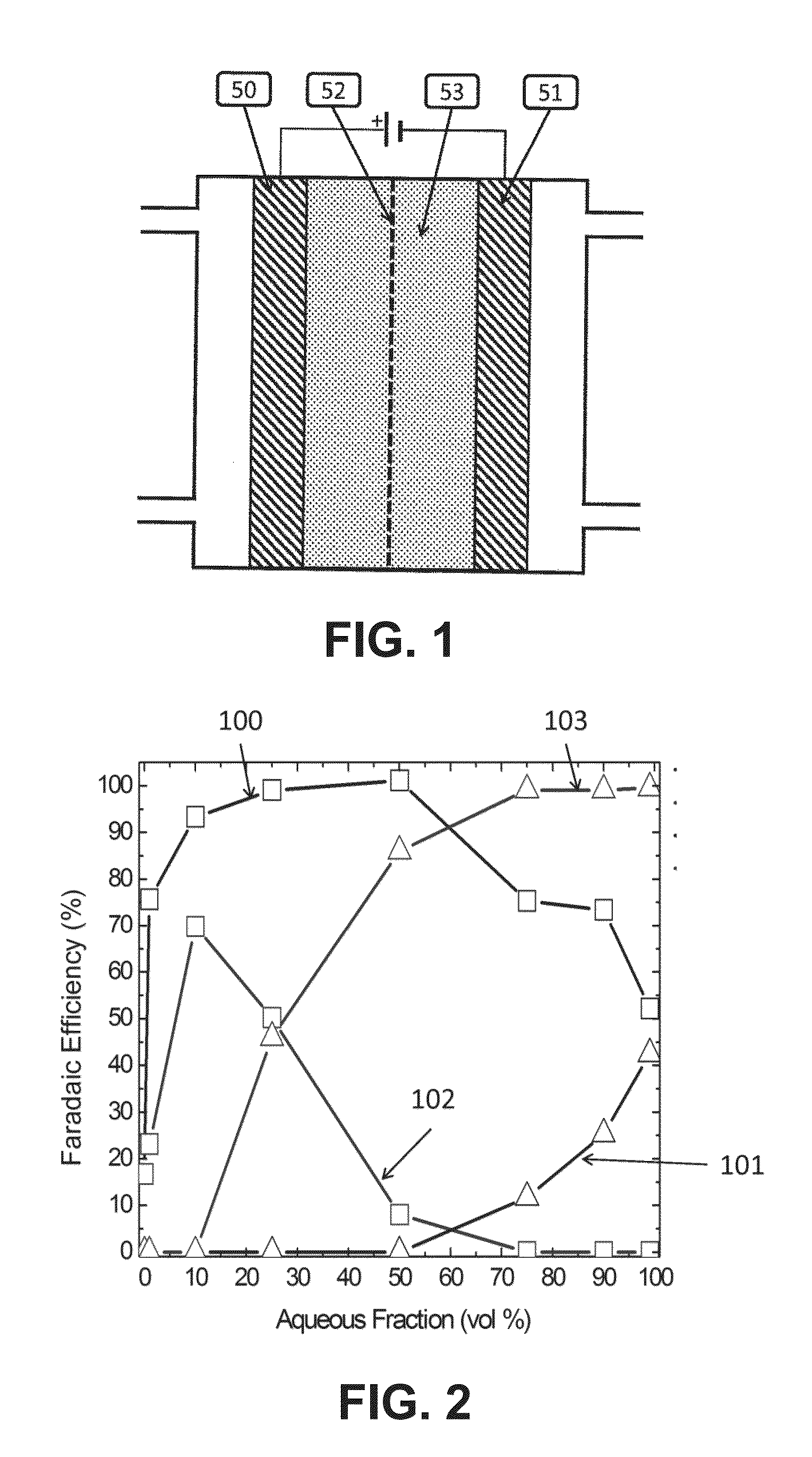Devices And Processes For Carbon Dioxide Conversion Into Useful Fuels And Chemicals
a technology of carbon dioxide and conversion device, applied in the field of electrochemistry, can solve the problems of requiring over 1-5 watts of power, too high for portable sensing applications, and the activity of the catalyst disclosed in these patent applications was less than desired, and achieves low rate, low electron conversion efficiency, and high overpotential
- Summary
- Abstract
- Description
- Claims
- Application Information
AI Technical Summary
Benefits of technology
Problems solved by technology
Method used
Image
Examples
example 1
The Effects of pH on the Efficiency of CO2 Conversion
[0090]The experiment used the flow cell described in Rosen et al., Science, 334, pages 643-644, 2011. It was a sandwich style reactor in which there were two liquid channels containing the catholyte and anolyte, and one CO2 gas channel. The gas channel was made of aluminum and was also the cathodic current collector. Just below the cathodic current collector was a piece of graphite gas diffusion layer (available from SGL Carbon LLC, Charlotte, N.C., USA, under the trade designation Sigracet) in which 10 mg of silver nanoparticles were made into an ink and painted onto an area of 1.5 cm2. The ink was made by mixing 10 mg of silver nanopowder (>100 nm diameter, Aldrich) with 600 μl of 18.2Ω ultra-pure water, 600 μl of isopropyl alcohol, and 10 μl of 1100EW 5% Nafion solution (DuPont). This mixture was then sonicated for 2 min. The platinum anode ink was made the exact same way except using high surface area platinum black nanopartic...
example 2
Tests in an Electrochemical Cell
[0098]Tests were also performed in an electrochemical cell. The experiments were conducted in a custom made three electrode electrochemical cell described in Rosen et al., The Journal of Physical Chemistry C 116, pages 15307-15312 (2012). The working electrodes were <100 nm silver nanoparticle catalyst (Sigma Aldrich) supported on a 5 mm diameter gold slug. The counter electrode was made of a 25×25 mm piece of platinum gauze purchased through Alfa Aesar. The gauze was connected to a 5 inch (12.7 cm) long 0.5 mm diameter platinum wire. The reference electrode was a silver quasi-reference electrode (Ag-QRE).
[0099]During the experiment, EMIM-BF4 was mixed with 0.001 M sulfuric acid to produce a mixture with a known pH. The mixture was loaded in the cell and sparged with argon to remove any residual CO2. Then the potential of the working electrode was held constant at −1.2, −1.3, −1.4 and −1.5 V with respect to the Ag-QRE and the current was recorded as a...
example 3
Extension to Platinum
[0102]The objective of this example is to demonstrate that the present electrochemical device also operates with a platinum catalyst. The experiments were conducted in a custom made three electrode electrochemical cell described in Rosen et al., The Journal of Physical Chemistry C 116, pages 15307-15312 (2012). Prior to sparging any gases into an electrochemical cell, the gases were sent through a tube of Drierite, anhydrous calcium sulfate (W.A. Hammond Drierite Co. Ltd.), in order to remove any residual moisture present in the gas streams. Working electrodes were high surface area platinum black (Alfa Aesar) supported on a 5 mm diameter platinum slug. The counter electrode was made of a 25×25 mm piece of platinum gauze purchased through Alfa Aesar. The gauze was connected to a 5 inch (12.7 cm) long 0.5 mm diameter platinum wire. The reference electrode was an Ag / 0.01 M Ag+non aqueous reference electrode (BASi, Bioanalytical Systems Inc., West Lafayette, Ind., ...
PUM
| Property | Measurement | Unit |
|---|---|---|
| pH | aaaaa | aaaaa |
| pH meter | aaaaa | aaaaa |
| concentration | aaaaa | aaaaa |
Abstract
Description
Claims
Application Information
 Login to View More
Login to View More - R&D
- Intellectual Property
- Life Sciences
- Materials
- Tech Scout
- Unparalleled Data Quality
- Higher Quality Content
- 60% Fewer Hallucinations
Browse by: Latest US Patents, China's latest patents, Technical Efficacy Thesaurus, Application Domain, Technology Topic, Popular Technical Reports.
© 2025 PatSnap. All rights reserved.Legal|Privacy policy|Modern Slavery Act Transparency Statement|Sitemap|About US| Contact US: help@patsnap.com



